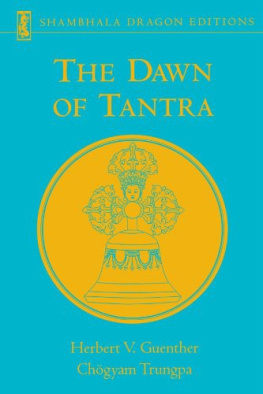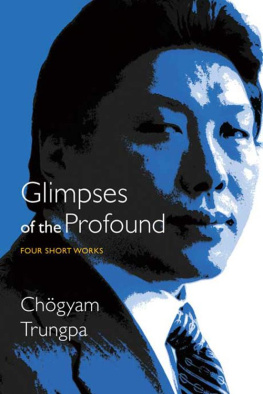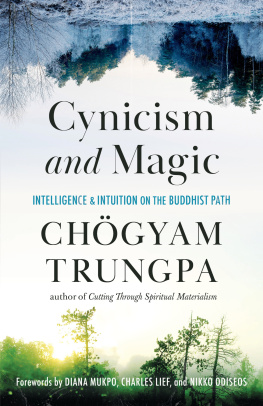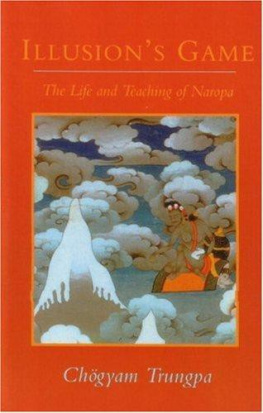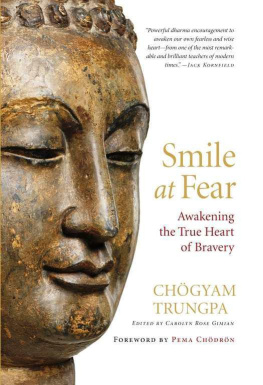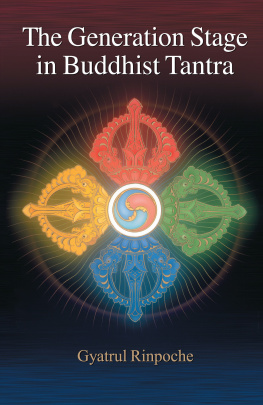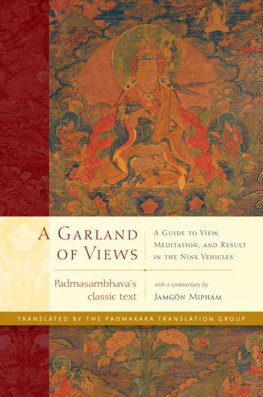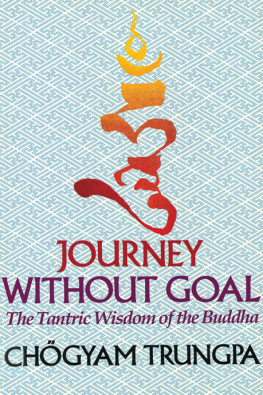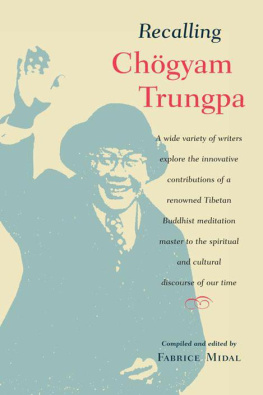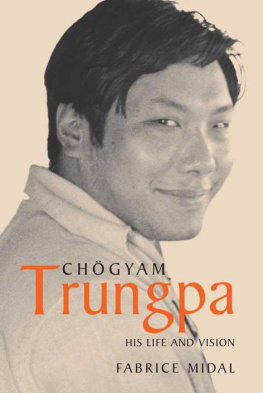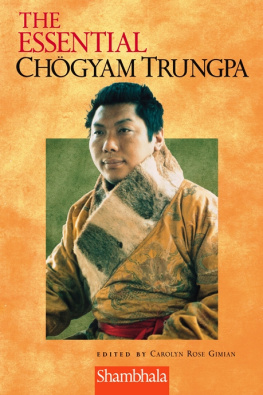The Dawn of Tantra
Herbert V. Guenther
and Chgyam Trungpa
edited by Michael Kohn
illustrated by Glen Eddy
and Terris Temple

Shambhala
Boston & London
2011
SHAMBHALA PUBLICATIONS, INC.
Horticultural Hall
300 Massachusetts Avenue
Boston, Massachusetts 02115
www.shambhala.com
1975 by Herbert V. Guenther and Chgyam Trungpa
All rights reserved. No part of this book may be reproduced in any form or by any means, electronic or mechanical, including photocopying, recording, or by any information storage and retrieval system, without permission in writing from the publisher.
The Library of Congress catalogues the previous edition of this book as follows:
Guenther, Herbert V.
The dawn of tantra
1. Tantric BuddhismAddresses, essays, lectures.
I. Chgyam Trungpa, Trungpa Tulku, 1939. II. Title.
BQ8916.G83 294.592 74-10250
eISBN 978-0-8348-2160-6
ISBN 978-0-87773-059-0
ISBN 978-1-57062-896-2
BVG 01
Contents
Chapters One, Three, Five, Seven, Nine and Ten are by Herbert V. Guenther
Chapters Two, Four, Six, Eight and Eleven are by Chgyam Trungpa
Introduction
W ESTERNERS WANTING to know about tantra, particularly the Buddhist tantra of Tibet, have had to work with speculation and fancy. Tibet has been shrouded in mystery; tantra has been called upon to name every kind of esoteric fantasy; Buddhism has been left either vague or inaccessible. Academic treatments have been of little help, being in the main inaccurate or remote, failing either to comprehend or to convey.
In The Dawn of Tantra the reader meets a Tibetan and a Westerner whose grasp of Buddhist tantra is real and unquestionable. Dr. Guenther holds Ph.D. degrees from the Universities of Munich and Vienna. In 1950, he went to India to teach at Lucknow University and, in 1958, became Head of the Department of Comparative Philosophy and Buddhist Studies at the Sanskrit University in Varanasi. Since 1964, he has been Head of the Department of Far Eastern Studies at the University of Saskatchewan in Canada. Because of his tremendous intellectual energy and scholarly discipline, knowledge of Tibetan, Sanskrit, and Chinese, and his years of collaboration with native Tibetans, he has become one of the few Westerners to penetrate to a deeper understanding of Tibetan tantric texts. His books, such as The Life and Teaching of Naropa and the Tantric View of Life, bring us nearly the only accurate translations and commentaries from the Tibetan Buddhist tradition.
Chgyam Trungpa was born in the heart of the Buddhist tantra tradition. As the eleventh incarnation of the Trungpa line of spiritual teachers, he was enthroned at the age of eighteen months as abbot of a group of monasteries in eastern Tibet. Beginning at three, he underwent intensive training in the intellectual and meditative disciplines of Buddhism. He had completely assumed his responsibilities, both spiritual and temporal, by the age of fourteen and went on to become a master of tantric Buddhist meditation. His journey toward the West began in 1959 when he fled the Chinese Communist invasion of Tibet. He first experienced the modern world in India, where he spent four years studying English. Since then he has traversed the West. He studied comparative religion at Oxford and founded a meditation center in Scotland. He arrived in the United States in 1970, where he has published several books, among them Cutting Through Spiritual Materialism, founded a number of meditation centers, a community working in art and theater, and another for helping the mentally disturbed, based on tantric principles. He has not remained cloistered, but has fully and frankly encountered the Western mind on the learned and gut levels. He has mastered English to the level of poetry.
Having worked toward each other, so to speak, for years, Dr. Guenther and Chgyam Trungpa met in Berkeley, California, in 1972, where together they gave a public seminar on Buddhist tantra. Dawn of Tantra is the edited record of that seminar, including part of the general discussion. The Visualization chapter is from a seminar given by Trungpa in San Francisco in 1973. The Empowerment and Initiation chapter is from a talk given by Dr. Guenther when he visited Trungpas meditation center in Boulder, Colorado, in 1973. Dr. Guenther has also since lectured at Naropa Institute, a university founded by Trungpa in Boulder, Colorado.
Guenther and Trungpa are an interface very much alive to the Tibetan tradition of Buddhist tantra and very much alive to the current everyday world of America. They communicate warmly and freely in both directions and give no quarter to wishful thinking.
S HERAB C HDZIN K OHN
ONE
Tantra
I TS O RIGIN AND P RESENTATION
T HE TERM TANTRA , from the time of its first appearance in the West up to the present day, has been subject to serious misunderstandings. The term was introduced into the English language in 1799 when tantric works were discovered by missionaries in India. These were not Buddhist works. In fact at that time it was hardly known in the West that such a thing as Buddhism existed. The term tantra was then known only as the title of these works, the contents of which were quite different from what people expected in books dealing with philosophy and religion. The missionaries were for the most part quite shocked that other people had religious and philosophical ideas so different from their own. To them the word tantra meant no more than these expanded treatises; but since the subject matter dealt with in these treatises was so unusual from their point of view, the term began to acquire quite a peculiar connotation, a connotation which proper study of the texts has not borne out. Unfortunately, in this case as in so many others, once a false conception has been formed, a nearly superhuman effort is required to root out and set right all the wrong ideas and odd connotations that have grown up around it. I am going to try to tell you what the term tantra actually means in a technical sense.
First of all, one must distinguish between the tantra of the Hinduist tradition and the tantra of the Buddhist tradition. These two traditions, both indigenous to India, for a long period of time used the same languageSanskrit. But each tradition stipulated particular uses for its terms. What one tradition understood by a specific term was not necessarily what the other tradition understood by it. When Buddhist studies originated in the West, which was only comparatively recently, it was assumed by the first investigators that since the Buddhists used the same Sanskrit terms as the Hindus, they would mean the same thing by them. This was the first of many wrong conclusions that they drew.

Padmasambhava (foreground) and dGa-Rab-rDorje (background).
D RAWING BY G LEN E DDY .
Let us apply ourselves to an understanding of tantra as it developed in the Buddhist tradition. A term that has been used from the beginning in close association with the term tantra is the Sanskrit prabandha. Prabandha means continuity. This is a continuity of being, which divides into two grounds: we have to start somewhere, and then go a certain way (and perhaps arrive at a goal). This is the way tantra was presented. It refers to an immediate human situation which arises out of the question of how we are going to be. Tantra also sees the question of how we are going to be in terms of relationship, realizing that man is always related to something or someone.
Tantra approaches the question of being in various ways; thus there is more than one presentation of it. The first approach is called kriyatantra. In the kriyatantra the emphasis is on how a person acts. Kriya means action. Action is here seen symbolically and dealt with in terms of ritual. We need not be mystified by the idea of ritual. An example of ritual is the custom of a mans removing his hat when he meets a lady. It is a kind of formalized gesture. It is also a way of going about a human relationship. The emphasis in the kriyatantra is on relationship as expressed in this kind of formalized gesture. In this case the emphasis is far-reaching and covers many aspects of relationship. The kriyatantra is further particularized in its approach to human relationship in that it deals with the simplest and earliest stages of it.
Next page
